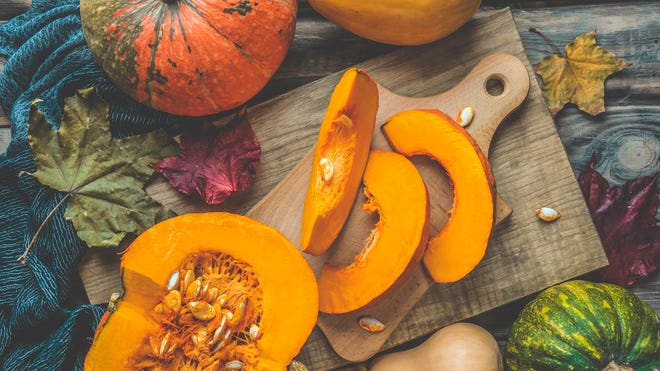We love a good food categorization debate: Is a tomato a fruit? Is a hot dog a sandwich?
But as fall weather creeps in and Halloween nears, we’re bringing our nutritional focus to what’s in season — namely, pumpkins.
“Fall produce brings in nutrient-packed options like pumpkin, squash, apples and Brussels sprouts, all of which are at their peak in flavor and nutrition,” Washington, D.C.-based dietitian Caroline Thomason, RD, CDCES, tells USA TODAY. “Think of it as nature’s way of giving us the best fuel for the colder months ahead. Seasonal produce tends to be fresher, more affordable and full of flavor because it’s harvested at its natural peak. Plus, the variety in fall produce makes it easy to fill your plate with color, which means a wider range of nutrients. It’s a delicious, nutritious way to celebrate the season.”
Is a pumpkin a fruit? Should you be eating more of it this fall? Here’s the nutritional breakdown on your would-be jack-o’-lantern.
Is pumpkin a fruit?
While some think of pumpkin as a vegetable because it’s sometimes used in savory dishes, it’s actually a fruit. Per Britannica, pumpkin is technically a type of berry called a pepo, which is a fruit that has a hard outer layer and no dividing chambers. (And for the record, squash is also technically a fruit.)
Love pumpkin spice?8 food and drink recipes to bring fall to your taste buds
Is pumpkin good for you?
It’s not just a great Halloween decoration — pumpkin contains a ton of great health benefits, too.
“Pumpkins are a powerhouse for your health,” Thomason says. “They’re loaded with fiber, which keeps you full and supports digestion, and they’re packed with beta-carotene, a potent antioxidant that our bodies convert into vitamin A for eye health and immune support. There are very few downsides to eating pumpkin, but it can be rich in carbs if you’re watching your intake.”
If cooking a fresh pumpkin doesn’t fit into your busy schedule, canned pumpkin is still a winner, Thomason says − but she adds a reminder to make sure you’re choosing regular canned pumpkin rather than pumpkin pie filling, which has “a significant amount of added sugar.”
“When comparing fresh pumpkin to canned, they’re nutritionally similar, but canned pumpkin often has a more concentrated amount of fiber and nutrients because it’s slightly more processed,” Thomason says. “Both options are great, but for convenience and cooking ease, canned pumpkin is a winner.”
Want more pumpkin? Pumpkin seeds are also edible — and offer a different set of health benefits compared to the rest of the pumpkin.
Pumpkin spice is the flavor of fall.But what is it? And where did it come from?
“They’re a fantastic source of healthy fats, plant-based protein and minerals like magnesium, which supports muscle and nerve function,” Thomason says. “They also contain more calories and fat than the pumpkin itself, so they make a great snack for boosting energy. Pair them with a carb source like an apple, popcorn or whole grain crackers for a balanced snack.”
